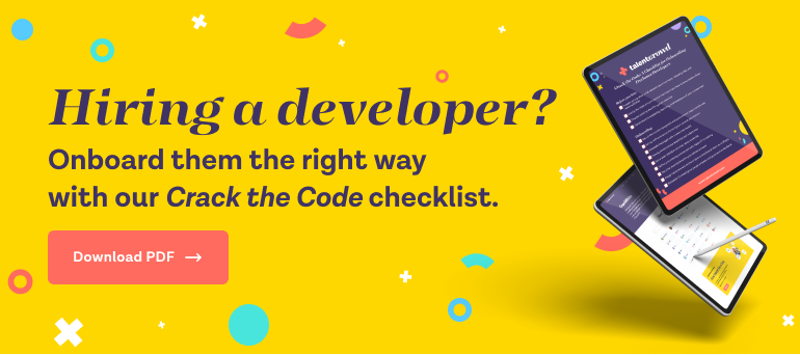Spoiler Alert: Attracting the Right Candidates Is All About the Experience
Building a solid team of employees is critical for success as a business. In a field such as software development, finding and hiring exceptional talent is a crucial task, and having an effective recruiting process makes all the difference.
Software developer positions are notably challenging to fill because of how technical they are. In a survey of technical leaders, eighty-six percent report that it is challenging to find technical professionals today. Additionally, a current shortage of developers intensifies the challenge of hiring and retaining developers.
As of 2021, the developer shortage amounted to 40 million workers across the globe. It is expected to rise to 85 million by the year 2030. The job market is highly competitive due to the lack of qualified candidates. There always seems to be another company that offers better incentives, a more desirable location, or higher salary potential.
Although recruiting developers can be daunting, an intentional hiring plan can simplify the process and ensure success. While there are many promising strategies for recruitment, the key to attracting quality candidates is simple: prioritize a positive candidate experience.
The candidate experience is arguably the most critical part of the hiring process. An outstanding candidate experience can effectively attract, impress, and win over the top candidates you want to join your team. A negative interaction does the exact opposite. Not only does the candidate experience determine whether or not people want to work for you, but it influences what they share with others, directly impacting your company's reputation. The way potential employees are treated is powerful.
So how does one create an outstanding candidate experience?
It doesn't have to be complicated. The objective of this article is to be a helpful resource and to provide all the information you need to feel confident in your software developer recruitment process. Here are ten recruiting tips to elevate the candidate experience and attract highly qualified candidates:
Tip #1: Encourage Referrals from Current Employees
One of the most effective recruiting strategies for finding top talent is using your employees' existing social networks. In a study conducted by CareerBuilder, 88% of employers rated employee referrals above all other sources for generated quality of candidates. It was also ranked highest for developing the best return on investment (ROI).
If done correctly, relying on employees for referrals can be self-replicating:
- Hire the best talent you can find
- Make sure they are content and challenged
- Encourage them to refer their talented friends
- Repeat
This method works best with a formal employee referral program that motivates people to source great candidates. Often, employees receive recognition and a reward for referring job seekers that turn into new hires. The incentive can be either a bonus, a stipend, or some other form of tangible benefit.
Using employee referrals provides significant benefits. It develops a culture of respect and trust which contributes to a positive work environment and boosts morale. It increases the likelihood of finding the most qualified candidates. It can also lower costs per hire due to its word-of-mouth marketing similarities.
Referrals can also come from former employees. However, social recruiting only works when all workers have a great experience. Emphasizing and striving for a healthy, positive work environment can go a long way, even after employees have moved on to a new job.
Tip #2: Create a Strong Job Posting
First impressions are essential, and a job posting is the first connection job seekers have with a company. If job descriptions are accurate and honest, they will reach the target audience. Also, it will entice the best candidates to apply if they are exciting and appealing.
A great job description focuses on what the company can offer a candidate and not solely on what the candidate is expected to provide for the company. It indicates a people-focused workplace where individuals are valued. Share the company's background, mission, and values. Discuss the company culture and team dynamics.
There should be clear role expectations. The job opening's duties, responsibilities, and experience should be easy to understand. Avoid company-specific jargon that only current employees would know. Also, avoid cliché or apparent requirements such as "detail-oriented" or "multitasking." The right talent will already exhibit these abilities.
In some states, salary transparency laws require that job postings include salary ranges. Regardless if it's mandatory or not, it's a good idea to list the salary range and benefits upfront. Knowing this information serves as an incentive for more candidates to apply. It also weeds out applicants who require a higher salary than can be afforded.
Tip #3: Prioritize Diversity
Having a diverse team is critical for success. More diverse and inclusive companies are 35% more likely to outperform their competitors. Not only is inclusion important for the workplace, but it's essential for recruitment. It creates a fair hiring process and a welcoming experience for candidates.
The most impactful way to promote diversity in recruitment is to identify and eliminate potential hiring biases. Whether conscious or unconscious, hiring biases influence someone's decision using criteria irrelevant to the job. Making assumptions about someone based on their gender, age, race, or education is harmful and unfair, and it can result in missing out on great talent.
Training hiring managers and the recruiting team to be self-aware is an effective way to reduce hiring bias and promote diversity. Another effective method is to have a strict, standard process that applies to all candidates. Ask every candidate the same set of defined questions and use the same way to rate them. Some hiring managers choose to go blind when reviewing applications, which means all information is hidden except for the relevant content. Putting in the effort to prioritize diversity will make your business stand out to quality candidates.
Tip #4: Simplify the Process
Recruitment processes should be simple. It may be too complex if it takes ten steps to get a candidate from the application to onboarding. Many recruiters make the mistake of believing that the more intensive it is, the better quality candidates they'll find. However, in reality, it is a waste of recruitment efforts because candidates will either lose interest, accept another job offer, or decide it’s not worth leaving their current position.
The entire hiring process needs to be streamlined. Make sure that the application is short and straightforward to fill out. Limit interviews to a set amount of time and stick to them. As software development is a specialized skill, the interview process usually includes a skills assessment. It also needs to be straightforward. The time limit should be reasonable - long enough to complete the task but not too long where it's draining. It should resemble a real-life task that they might encounter on the job. There should also be a set, predetermined rubric to evaluate the results.
Candidates will notice if the hiring team is considerate of their time. A drawn-out recruiting process can result in a poor candidate experience and the loss of quality talent.
Tip #5: Ask Great Questions
Regarding the interview process, it's equally as crucial for the hiring manager to be prepared as it is for the interviewees. A lack of preparation can be interpreted as a lack of interest and respect.
There should be a set list of predetermined interview questions for all candidates. These questions must be relevant to the job and helpful in identifying the most skilled candidates. Not only are technical questions necessary, but you should include behavioral ones. Soft skills are just as necessary as hard skills.
Asking good questions, listening attentively, and having more follow-up questions to continue the conversation all contribute to a positive and memorable interaction with the hiring team.
Tip #6: Practice Strong Communication
Throughout the whole hiring process, candidates should always feel clear. If they are unsure about the next steps, the hiring manager needs to communicate better and avoid losing out on the best candidates.
It can be beneficial to assign someone on the recruiting team to be a point of contact for candidates. They should correspond frequently and promptly and encourage applicants to reach out anytime. This person should communicate clearly about interview schedules, timelines, and other critical information. Potential employees will appreciate thoughtful details such as directions to the office or instructions on using a video conferencing tool for a virtual interview.
If an applicant is not the right fit, communicating this to them in a respectful manner is essential. It can be as simple as a polite email stating they were not selected and thanking them for their interest and time. A candidate who is clear about the status of their application, regardless if you didn’t choose them, is less likely to have a negative opinion of the company.
Tip #7: Embrace Working Remote
Since the beginning of the Covid-19 Pandemic in 2020, working remotely and following hybrid schedules has increased. It is highly appealing to job applicants and specifically to software developers. Software development isn't limited to office space, and more and more top talent no longer want to consider it.
Adapting to allow for remote work has its advantages. It reduces operating expenses. Often it increases productivity in employees. It can also make job descriptions more attractive to highly qualified candidates. Even more beneficial, it increases the talent pool for potential new hires because there is no limit to geographical location.
Tip #8: Develop an Employer Brand
Employer branding is a marketing strategy used to manage and shape its reputation to the public and promote its values and employment experience. Creating and establishing an employer brand helps to appeal to the target audience. It also gives employees and job candidates values to see if they’d be a good fit.
While employer branding has many elements, such as design and storytelling, the most critical part of attracting good employees is the employee value proposition. It represents everything of value offered to employees in exchange for the qualities, experience, and skills they bring to the position.
A strong employer brand encompasses why employees are proud and motivated to work there. It attracts the best talent and drives them to apply for open positions. As long as it is accurate to how the organization truly is, it's an excellent, effective recruiting strategy.
Tip #9: Value Each Applicant
One of the best ways to prevent a poor experience is to treat candidates well. Applicants should feel valued, respected, and important even before joining the team. Interviewing for a new job can be intimidating, and good recruiters know how to make them feel welcomed and appreciated.
It's the small things that matter and conveys that you care. A smile goes a long way. Be friendly and personal during interactions, and address each candidate by name. Show up on time to interviews and be mindful of their schedules. Have prompt communication throughout all the recruiting steps. Brush up on vital information to be prepared to answer questions.
Just because you didn’t choose someone for the position doesn't mean they aren't an excellent fit for another team or future job opening. Be personal and appreciative of rejections because they could one day be a new hire. Try to highlight what they did well and encourage them. Ask them to stay in touch and apply for other open positions.
Tip #10: Try Collaborative Hiring
Collaborative hiring is a team-based approach that involves a group of colleagues. All new employees will impact their team and the work around them. It can be helpful to involve multiple department members to find the right talent.
Team members often have unique insights into what kind of person is needed for the position and the team. They can assess the cultural fit much better than outside hiring managers. Even if they are not involved in the actual interview, allowing them to interact with candidates and share their thoughts can help lead to better success.
Including employees in the hiring process can help to draw in skilled candidates. Current team members have first-hand experience that they can share with the candidates. They can vouch for the employer brand and honestly answer questions about their experience within the company. Collaborative hiring is needed to convince the most qualified candidates to accept a job offer.
To Summarize
Although a shortage of software developers can complicate the hiring process, the summary of all ten tips and the secret to recruiting the best candidates is simple: provide a positive candidate experience. Attracting top talent starts with how you treat them.
Finding quality candidates on your own is one of many options. Working with a professional recruiter like Talentcrowd can help you reach more skilled candidates than you can. Talentcrowd is a hiring platform that matches talented developers to companies and teams.
Talentcrowd only recruits the most qualified candidates who are thoroughly vetted and screened on technical capabilities and soft skills. Technical teams who are remote, outsourced, and hand-picked for each specific project. Working with Talentcrowd gives businesses immediate access to relevant, quality expertise and a wide range of skills and knowledge. Consider partnering with Talentcrowd to recruit the best candidates and build the ideal tech team for your business.
Finding and hiring top talent can be easy. The recruiting process will be easy and effective if you focus on creating an excellent candidate experience.




